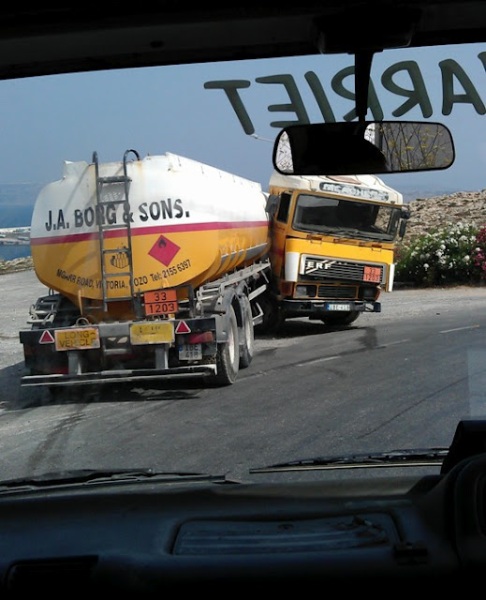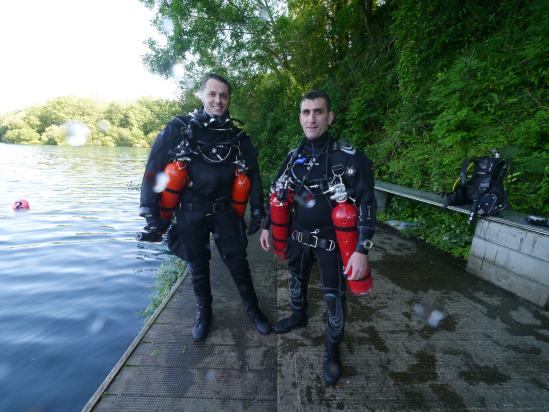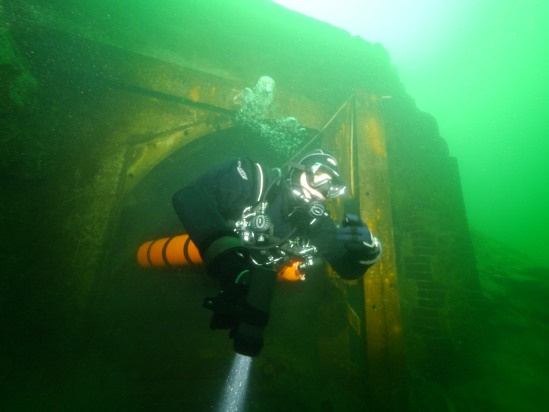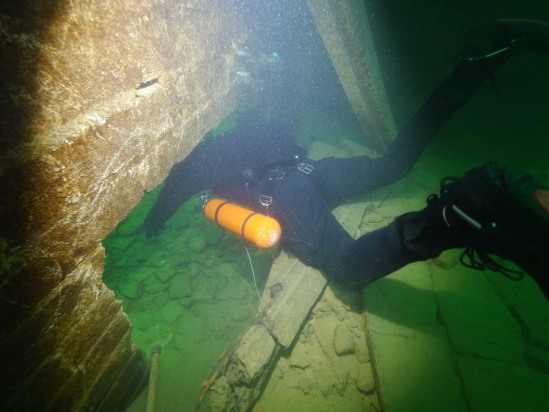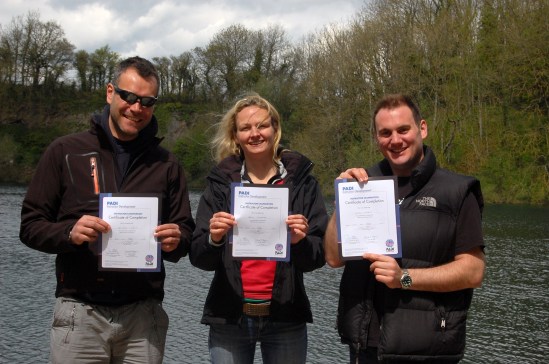Monthly Archives: July 2012
Sidemounting in the material world
Last week I headed down to Tek camp at Vobster Quay with Leo from Ocean Leisure. We had only one thing on our minds: Sidemount. Yes I realise that sounds wrong, but let’s be honest you can add that to the list of diving terms that must be spoken cautiously out of context: Wreck penetration, blown O-rings, lubed wrist seals, pee valves and ball-gags all spring to mind (perhaps not the last one).
Anyway Sidemount is the latest trend to take the dive industry by storm and I’d been eager to have a go and find out what all the fuss was about. Sidemount is, exactly as the name suggests, mounting twin cylinders to the sides of your harness instead of on your back. If you’re diving recreationally you can take a couple of smaller ones, twin 7ls are very nice, and if you’re diving technically larger ones like twin ali 80s or 12l steels work well.
The principle of sidemounting cylinders is born out of the cave diving community where not having cylinders on your back enables you to squeeze through even smaller holes into caverns where you can get lost and die. Now those who know me will probably have heard my opinion on the fetishistic treatment of cave diving techniques by divers who don’t go into caves but you can’t knock something until you’ve tried it (another utterly asinine cliché, murder anyone?) so I was up for giving it a go.
Leo and I were looked after by the lovely chaps at Apeks/Aqualung who are also the distributors for Whites drysuits. It was lots of fun to rock up wearing my top of the range bullet skin with silicone lock seals but not quite as fun seeing the guy from Bare drysuits there whom I hadn’t told we were now a Whites dealer. Awkward.
Dean Martin (not that one) from Apeks helped us get geared up. The first thing to notice about sidemount harnesses is that they contain a lot of bungee which is a good thing, as all divers know the more bungee present the better, and the harness fits you much more snugly than most BCDs or other harnesses. The inflator hose comes across your chest and is held in place so that the wing inflator sits right next to your drysuit inflator. This makes it very easy to find but also means you can’t use it to vent air so you have to use the kidney dump on the wing to do this.
The tanks are then clipped onto the harness on a D ring at the waist but then instead of being clipped to a D ring on the shoulder of the harness they are looped into the bungee. this keeps them nice and snug next to you but also means that they can be moved around and manipulated if you need access to the valves.
We were using Apeks new sidemount regulator set: The right hand regulator feeds the wing inflator and has a 2m hose with a 2nd stage, the left hand reg feeds the drysuit with a really neat short hose and also has a shorter hose with a necklaced 2nd stage. Tec divers will find this arrangement pretty familiar. The setup was very tidy and routed in a very natural way. The principle is that you breathe equally from each reg, Dean told us he usually breathes about 40 bar from each reg.
The advantage of all this get up is that you end up with 2 completely independent cylinders that you can access very easily. Therefore shutdowns become a cinch in the event of a regulator free flow and should you have a catastrophic gas loss you know that the air in the other cylinder is completely safe.
So once we were all trussed up we headed over to the water and jumped in. Pretty much the first thing I noticed was how if you’re a diver who’s used to diving in a twinset, this isn’t going to faze you too much. However it was definitely noticeable how easy it was to get into a perfect horizontal trim, the cylinders at your side act like balancing weights almost forcing you into the correct position, no instability or roll from a single tank or the occasional sense of top heaviness from a twinset.
We headed off for our dive, both Leo and I were using the new Finnlight torches, which were 1400 lumens and were very nice and compact with a couple of power settings. There was a comedy moment when Dean fired up the video light on his camera housing, a 10,000 lumen torch (yes 10,000 lumens) which resembled an ammunition clip for a plasma rifle. This illuminated the whole of Vobster Quay and meant that anytime you glanced in his direction I was reminded of the scene at the end of Close Encounters when the doors of the spaceship open.
Being completely unused to breathing from independent cylinders I certainly didn’t find switching every 40 bar to be that intuitive but that’s really just a practice thing. I also enjoyed wriggling through some holes around the crushing works where having no tanks on your back means you don’t get that slightly brown drysuit moment when the tank makes a loud ‘bong’ noise as it collides with whatever’s above you.
So in conclusion what’s the verdict? Do I think that everyone should go out and burn their BCDs and twinsets and only ever dive sidemount ever again? Of course not, but I do think that sidemount is an intriguing extra option. There’s no doubt that it feels very nice in the water and for anyone who struggles with horizontal trim I think they would find this a very nice way to dive. However from a recreational perspective you do have the added complication of remembering to breathe from 2 separate tanks. I have also heard from other divers that gearing up in sidemount on a moving boat is more complicated that climbing into a BC or twinset and I could definitely see how that would be the case. From a tec perspective I think it would be a fantastic way to do a tec40 style dive, racking up a bit of deco on air or nitrox. I think sidemount is probably one of those things that some divers will do and instantly fall in love with (it will certainly appeal to those who like their gadgets!)
We’ll definitely be looking to bring some sidemount action to DLL soon so watch this space for more news!
One small step for man, one giant leap for mankind!
The trials and tribulations of an IDC and an IE (written by Alistair Wolf)
Okay where to start? Are you sitting comfortably? Then I will begin. Once upon a time there were 3 DMs – Jen, Chris and Alistair. These 3 DMs used to look on in wonderment at the DLL instructor team, wishing they could demonstrate the perfect fin pivot and the ultimate ‘funky Buddha’, or should I say PPB, and then one day it was decided by the powers that be that these 3 DMs would step forth and go where no man (or woman) has gone before…
Okay, okay, enough, otherwise I could go on for hours writing this with a million one liners! So I’ll get down to the serious account of what it’s like to get through an IDC (Instructor Development Course) and an IE (Instructor Examination). It ain’t easy but someone has to do it! Last one I promise … well maybe not?
So Jen, Chris and I between the 3 of us thought it would be a great idea to further out PADI career and go for the OWSI (Open Water Scuba Instructor) and boy oh boy what a journey!
All of us had been DMs for about a year and had been pretty busy supporting the instructors on open water courses, scuba referrals, bubble makers and DSDs. So between us we had certainly built up a certain level of confidence which we hoped would put us in a great place when it came to the IDC. Oh I wish that were the truth!
By the end of 2011, we all had our PADI crew packs and were keen to get started. That was the first challenge, trying to coordinate our three calendars plus one elusive course director (Sir Paul Vincent Toomer). Eventually the IDC date was set for 2 weekends in March with an aim to take the IE on the 5th/6th May. So the dates were booked in our iphone calendars and now it was up to the 3 of us to study, present using PADI prescriptive training, and practice skill after skill after skill– thankfully we had two very able IDC Staff Instructors in the guise of Mr David Lau-Kee and supported by Mr Aidan Hardy.
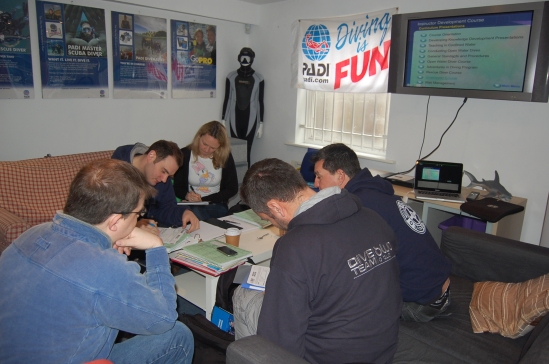
Working hard in the Deco Lounge
I have to say the first weekend of training with DLK and AH was, and I am going to be very blunt, bloody tough. The problem was that we all knew we were competent DMs and all able to dive to the highest standard, but the standards set by DLK were way higher than that and we were all making simple mistakes that we would certainly be penalised on when going through the IDC/IE. However, we persevered and we got through scoring high 4’s (marked out of 5). An easy pass, but then this lead to other problems that we were all striving for 5’s and kicking ourselves when this was not met. Am sure this was a great problem to have from DLK/AH perspective.
The next challenge was presenting the PADI way, although I have to say in hindsight we made it a lot harder than it actually was as PADI have designed superb training tools to aid presentations and if you follow this – yep, you guessed it, a high 4’s out of 5 and even the odd 5 too!!
After 2 weekends of stress and thinking actually life as a DM is not that bad – DLK was comfortable that we had met the standards that PVT would expect. So that was it, we were ready for the IDC…bring it on. Although there was still the dark shadow of the multiple choice exams in physics, dive equipment, general standards/procedures, physiology and the environment – so it meant cramming. Which I have to say was not an easy thing to do especially when faced with going to work all day and then in the evening opening PADI manuals, test papers and trying to remember how ERDPs work!
So March came and the IDC started and what a crammed weekend with early starts and long days – but I have to admit I was actually having fun. We all were, the 3 of us all found our confidence and with the fantastic guidance from PVT and Co we all had a good feeling that we were going to get through this. It still was not easy but PVT has a great way of explaining things and putting it in a different perspective that is easy to grasp. Yes it has to be said he is a diving god and if you ever get a chance to go on a course with this dude – just do it!
The IDC consisted of two full weekends, a mixture of lectures, confined and open water pool work, giving presentations, briefings and debriefings – but my god did they fly by and before we knew it we had finished and Paul was happy that we were at the appropriate level to cruise through the IE. But we all knew a stupid mistake could mess all that up. Only time would tell!
In no time at all the IE was upon us and we all drove down to Bristol – all nervous, apprehensive, quietly confident and have to say a little scared. I think this was because we just did not want to fail, with DLL having a phenomenal success rate with all AI’s – they all seemed to pass – and there was no way anyone of us wanted to mess up that statistic.
IE DAY 1 / Bristol
After a nervous night’s sleep at Bristol’s finest premier inn – we headed to the school where the IE was going to take place. It was an early/prompt start, 0730 at the school. We all shuffled into an exam hall (yes just like taking your O levels, or should I say GCSE’s). We were all expecting a friendly presentation, chat etc etc. But no it was straight into it, a quick summary of what we were to expect and then that was it multiple choice exams followed by a prescriptive presentation and then confined water skills. If we get through day 1, day 2 and then being an OWSI would be within our grasp.
A point to note, if you fail one of the exams or mess up on the presentation you can do something called a ‘makeover’. Basically you re sit during the same weekend. More than one you have to come back at a later date – so yes the pressure was on every single one of us. Although I have to admit a certain Mr Chris Lovett was mightily chilled out by the whole thing. So what happened next – we all passed, no idea of scores and marks out of 5 but all we know is that we passed everything. From the exam perspective (open and closed book) – another point to note is, don’t let the general standards and procedures open book exam fool you. Yes the answers are in front of you but there are 50 intense questions and you only have 3 hours to complete, wow did those 3 hours go quickly. If anything this was harder than the multiple choice exams. But we had all done it, just day 2 to go. But before that, a 40 mile drive over to ‘the George’, Mells, Somerset where a pub lunch and a pint of Wadsworth beer was in order. We all crashed early; as you guessed it another early start was beckoning.
IE DAY 2 / Vobster
So this was it day 2, get through this and then the stress of the IDC will be a dim and distant memory! So day 2 consists of giving skill briefing/debriefing, demonstrating skills, noticing mistakes by a ‘pretend’ open water student. As well as demonstrating recovering a non breathing diver from the surface. This as per day 1 all was being marked out of 5. The examiners just hang motionless in the water (have to say a perfect hover) with a slate noting every mistake you make and then give you feedback and score once the skill has been completed.
So what was the outcome I hear you all ask – well I am sure you all know how this story ends, as you have all seen the snorkel celebrations and seen these 3 professional instructors (damn it, I gave the ending away) getting ‘blattered’ at the Eagle. Yep Jen, Chris and I (Alistair) passed and from what I gather we passed with flying colours and the DLL statistic is still at a 100% pass rate! So the pressure is now on all you DM’s waiting to take the OWSI leap!
So to summarise, the IDC / IE is a phenomenal experience. It draws on every emotion, but one thing for sure it’s a lot of fun. I am proud to say that Jen and Chris were the best IDC buddies I could ask for. We gelled, we supported each other at every hurdle and we did it, we did it and even now after 2 months of being an Open Water Scuba Instructor I am still chuffed to bits and I just know it’s the best feeling ever and would recommend anyone who is thinking about going for their OWSI – don’t delay and just do it!!
Finally I would like to say a huge thanks to all the DLL team, have never met a better bunch of people especially David Lau-Kee (perfectionist extraordinaire), Aiden Hardy (who has everything dive related in the back of his jeep), Alex (who gave me the confidence in physics) and finally Paul V Toomer (spoon buddy, although word of warning take ear plugs if sharing a wigwam with this dude).
Thanks to all and just keep diving!
Alistair (OWSI 286891)

